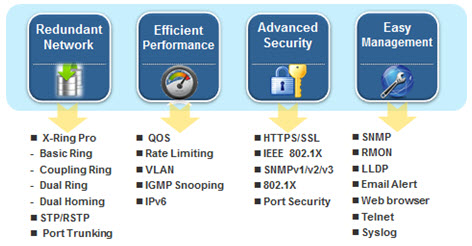The basic difference between a managed and unmanaged switch is the intelligent features. A managed switch is packed with more features for intelligent networking, such as network redundancy and SNMP monitoring. An unmanaged switch offers simple, plug-and-play setup, but its directive is merely to allow Ethernet devices to connect without traffic controlling, much like a direct Ethernet connection would.
Managed switches have more capability than unmanaged switches but also require more administrator or engineer skills to incorporate efficiently and effectively. A managed switch allows you have better control of your network and the traffic moving through it by providing redundancy, security and efficiency features. Conversely, an unmanaged switch requires little set-up knowledge, as it is a simpler device, allowing Ethernet devices to communicate with one another automatically using auto-negotiation to determine parameters such as the data rate and whether to use half-duplex or full-duplex mode.
Advantech’s EKI-7000 Series Industrial Managed Ethernet Switches allow data taransmission rates up to 1 Gbps and incorporate X-Ring technology to enable a redundant ring recovery time of (< 20ms) ensuring secure data communication, reliability and high-speed network infrastructures. They also feature the controlled management of VLAN/GVRP, QoS, IGMP Snooping/Query, LACP, Rate Limit and Security enhancements with IP/MAC and port binding, DHCP Server and IP access list. Ensuring routing for only eligible traffic.
A managed switch provides greater control over how data travels over the network and who has access to it. Managed switches generally offer SNMP (Simple Network Management Protocol), which allows you to monitor the status of connections and gives you statistics like traffic throughput, network errors and port status.
Redundancy
One of the most defining features of a managed switch, the ability for a network of the switch to reconfigure a network when a failure occurs is often the compelling reason for its purchase and implementation. For Industrial networks that remain functional under a single cable loss, Advantech offers Gigabit X-Ring redundancy in their managed switches to intelligently ‘heal’ the network at industry-leading speed. The ultra high-speed recovery time is < 10ms (read: less-than 10 milliseconds).
Security
Separate from unmanaged switches, managed switches control traffic at the IP address level. At a time when network security features are a top priority or industrial networks, a managed switch needs to come standard with IP/MAC and port binding, DHCP Server, IP access list and other settings to protect down to limiting traffic to specific addresses.

Advantech EKI-7000 Series Software Features |
Efficiency and Performance
The intelligent traffic control that set the managed switches apart include QoS port setting features that can assign a high priority to time sensitive data and video streaming. Also, many managed switches include IGMP snooping, giving the switch the ability to ‘listen in’ to the conversation between host and routers, and map of which links need which IP multicast streams.
How can you tell which type of switch is the right one for your application? One tip is to give yourself a short-list defining your network’s requirements, including any need for traffic control, what protocols you will support, and needs for secure features. You must provide this list in a future view. As a top priority in this list, and an easy indicator of a recommendation to a managed switch, is whether the network carries mission critical data, requiring uninterrupted up-time. If the answer is ‘yes’ to this, then a network containing managed switch topology is right for you.

